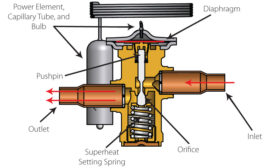Home » TXV (thermostatic expansion valve)
Articles Tagged with ''TXV (thermostatic expansion valve)''
Devices can improve evaporator efficiency in refrigeration and air conditioning systems
Read More
The Symptoms of a Restricted TXV
How to identify when a liquid-line restriction is starving a system of refrigerant
Read More
Troubleshooting Thermostatic Expansion Valves
If you believe that the TXV is the cause of a system problem, first try adjusting the valve
Read More
Operating and Troubleshooting Thermostatic Expansion Valves
There is still a lack of knowledge about TXVs in the market
Read More
Copyright ©2024. All Rights Reserved BNP Media.
Design, CMS, Hosting & Web Development :: ePublishing














